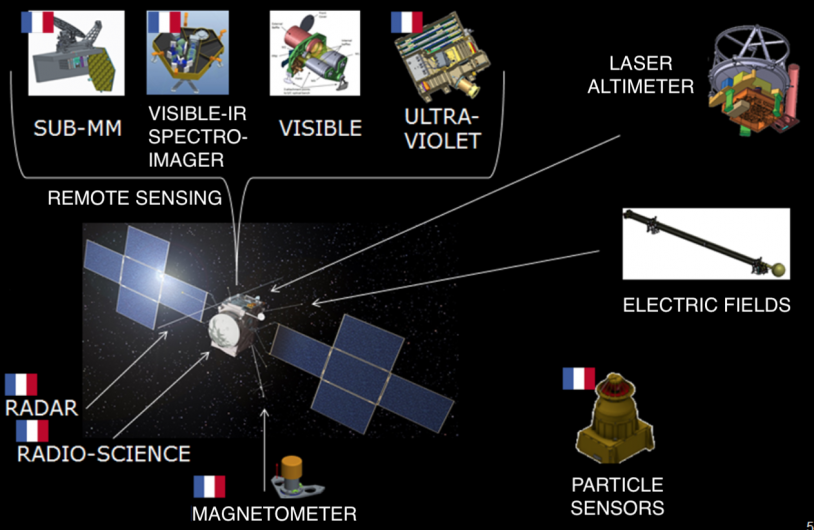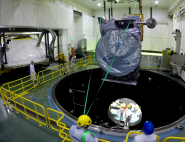Instruments
JUICE instrument packages
The JUICE payload consists of 10 instruments designed to fulfil the mission’s science goals. These instruments are contained in three packages:
A remote-sensing package comprising an optical camera (JANUS, supplied by the Università degli Studi di Napoli “Parthenope”, Italy) and spectral-imaging capabilities from the ultraviolet to the sub-millimetre wavelengths, with MAJIS (supplied by the IAS space astrophysics institute, France), UVS (supplied by the Southwest Research Institute, USA) and SWI (supplied by the Max-Planck-Institut für Sonnensystemforschung, Germany).
A geophysical package comprising a laser altimeter (GALA, supplied by the Institute of Planetary Research, Germany) and a radar sounder (RIME, supplied by the Università degli Studi di Trento, Italy) for exploring the surface and subsurface of the moons, and a radio science experiment (3GM, supplied by the Sapienza Università di Roma, Italy) to probe the atmospheres of Jupiter and its satellites and to measure the gravity fields.
An in-situ package comprising a suite of instruments to study the particle environment (PEP, supplied by the Swedish Institute of Space Physics, Sweden), a magnetometer (J-MAG, supplied by Imperial College London, UK) and a radio and plasma wave instrument (RPWI, supplied by the Swedish Institute of Space Physics, Sweden), including electric field sensors and a Langmuir probe.
An experiment (PRIDE) using ground-based very-long-baseline interferometry (VLBI) also provides precise determination of the spacecraft’s position and velocity and is able to determine the gravity field of objects overflown.

The table below lists the instruments in the JUICE payload, with flags indicating the nationality of the Principal Investigator (PI) leading the consortium tasked with developing each instrument (a more detailed description of instruments to which France is contributing is given in a second table; these instruments are indicated by an asterisk (*)).
JUICE INSTRUMENT PACKAGES
| Instrument | Science contribution | Description |
| JANUS - Camera system | An optical camera to study global, regional and local morphology and processes on the moons, and to map the clouds on Jupiter. | JANUS will have 13 filters, a 1.3-degree field of view, and spatial resolution up to 2.4 m on Ganymede and about 10 km at Jupiter. |
MAJIS - Moons and Jupiter Imaging Spectrometer (*) | A hyperspectral imaging spectrometer for observing tropospheric cloud features and minor species on Jupiter and for the characterization of ices and minerals on the surfaces of icy moons. | MAJIS will cover the visible and infrared wavelengths from 0.4 to 5.7 microns, with a spectral resolution of 3-7 nm. The spatial resolution will be up to 25 m on Ganymede and about 100 km at Jupiter. |
UVS - UV imaging Spectrograph (*) | A UV spectrometer to characterize the composition and dynamics of the exospheres of the icy moons, to study the Jovian aurorae, and to investigate the composition and structure of the upper atmosphere. The instrument performs both nadir observations and solar and stellar occultation sounding. | UVS covers the wavelength range of 55-210 nm with spectral resolution of <0.6 nm. Spatial resolution will reach 0.5 km at Ganymede and up to 250 km at Jupiter. |
| SWI - Sub-millimeter Wave Instrument | A submillimetre wave instrument to investigate the temperature structure, composition and dynamics of Jupiter's stratosphere and troposphere, and the exospheres and surfaces of the icy moons. | SWI is a heterodyne spectrometer using a 30-cm antenna and working in the spectral ranges of 1080-1275 GHz and 530-601 GHz, with a spectral resolving power of around 107. |
GALA - GAnymede Laser Altimeter (*) | A laser altimeter for studying the tidal deformation of Ganymede and the surface morphology and topography of the icy moons. | GALA has a 20-m spot size and 0.1-m vertical resolution at 200 km. |
RIME - Radar for Icy Moons Exploration (*) | An ice-penetrating radar to study the subsurface structure of the icy moons down to 9 km with vertical resolution of up to 30 m in ice. | RIME operates at a central frequency of 9 MHz (1- and 3-MHz bandwidth) and will use a 16-m antenna. |
| J-MAG - A magnetometer for JUICE | A magnetometer to characterize the Jovian magnetic field, its interaction with the internal magnetic field of Ganymede, and to study s | The instrument uses inbound and outbound fluxgate sensors mounted on a boom. |
PEP - Particle Environment Package (*) | A plasma package with sensors to characterize the plasma environment in the Jovian system. | PEP measures density and fluxes of positive and negative ions, electrons, exospheric neutral gas, thermal plasma and energetic neutral atoms in the energy range from <0.001 eV to >1 MeV with full angular coverage. The composition of the moons' exospheres is measured with a resolving power of more than 1,000. |
RPWI - Radio & Plasma Wave Investigation (*) | A radio plasma wave instrument to characterize the radio emission and plasma environment of Jupiter and its icy moons. | RPWI is based on four experiments: GANDALF, MIME, FRODO, and JENRAGE. It uses a set of sensors, including two Langmuir probes to measure DC electric field vectors up to a frequency of 1.6 MHz and to characterize thermal plasma and medium- and high-frequency receivers, and antennas to measure electric and magnetic fields in radio emission in the 80 kHz-45 MHz frequency range. |
| 3GM - Gravity & Geophysics of Jupiter and Galilean Moons | A radio science package comprising a Ka transponder and an ultrastable oscillator. | 3GM is used to study the gravity field—up to degree 10—at Ganymede and the extent of internal oceans on the icy moons, and to investigate the structure of the neutral atmospheres and ionospheres of Jupiter (0.1 - 800 mbar) and its moons. |
| PRIDE - Planetary Radio Interferometer & Doppler Experiment | PRIDE uses the standard telecommunication system of the JUICE spacecraft and VLBI (Very Long Baseline Interferometry) to perform precise measurements of the spacecraft’s position and velocity to investigate the gravity fields of Jupiter and the icy moons. |
INSTRUMENTS TO WHICH FRANCE IS CONTRIBUTING
Name | Instrument | PI | Units | French lab |
Hyperspectral imaging spectrometer | Y. Langevin / F. Poulet (France) | OH (Optical Head) | IAS (ME + sensors) | |
Submillimetre Wave Instrument | P. Hartogh (Germany) | TRU (Telescope and Receiver Unit) | LERMA (EU) LAB (****) | |
Radio and plasma wave instrument | J.E. Wahlund (Sweden) | SCM (Search Coil Magnetometer) | LPC2E (MIME) (*) LPP (SCM) LESIA (***) IRAP (***) | |
Particle environment package | S. Barabash (Sweden) | PEP-Lo (SHVPS) PEP-Hi (MCP) | IRAP | |
Radar | L. Bruzzone (Italy) | RDS (Receive and Digital Subsystem) | IPAG (**) | |
UV spectrometer | R. Gladstone (Unites States) | Single unit | LATMOS (Grating) |
(*) MIME is the French contribution included in EBOX, on the LP board
(**) Contribution to the mission ground segment
(***) JENRAGE (Jovian ENvironment Radio Astronomy and Ganymede Exploration, no hardware contribution)
(****) Development of an Operations Planning Tool for the SWI instrument's acquisition modes


